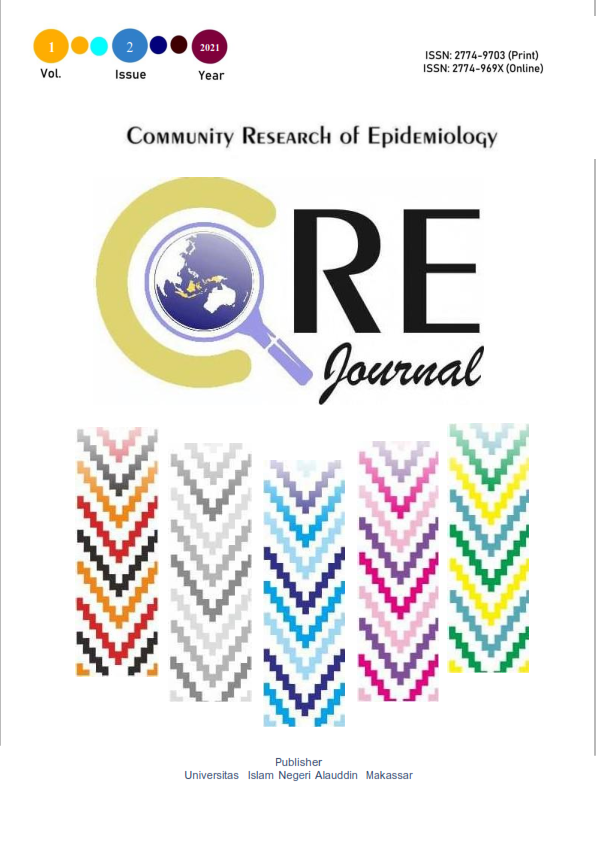Factors Associated with the Incidence of Diarrhea in Toddlers in Legok Village
Abstract
The number of diarrhea cases in children under five in Jambi City in 2019 was 3,621 cases. Of the 20 existing community health centers, the Putri Ayu community health center had the highest prevalence, namely 11.79% cases of diarrhea in children under five. Kelurahan Legok is a sub-district in the working area of the Putri Ayu community health center with the highest cases of diarrhea in under-five, namely 45 cases. The research design was case control. The sample of the research case was 45 mothers who had diarrhea with toddler, the control sample was 45 mothers who had no diarrhea. The research instruments were questionnaires and observation sheets. Data collection techniques are interviews and observation. Data were analyzed by univariate and bivariate using the chi-square test. The analysis showed that 73.2% of respondents had low risk clean water facilities, 57.1% of respondents had medium risk latrines and 60.7% of respondents had good parenting styles. The biariat results showed a relationship between clean water facilities (p = 0.016; OR = 6.25), latrine risk level (p = 0.015; OR = 4.6) and parenting patterns (p = 0.014; OR = 4.9) with the incidence of diarrhea in children under five in the Kelurahan Legok, the Working Area of the Putri Ayu community health center, Jambi City in 2020. The community health center conducts community empowerment in relation to the availability of basic sanitation facilities to reduce the risk of diarrhea incidence Increase parental awareness in preventing diarrhea through efforts to improve maternal parenting, both feeding practices, caring for toddlers, maintaining personal and toddler hygiene and time to interact with toddlers.
References
Adisasmito, W. (2011). Faktor Resiko Kejadian Diare pada Bayi dan Balita di Indonesia. Jakarta: Rineka Cipta.
Dinas Kesehatan Kota Jambi. (2020). Kejadian Diare di Kota Jambi Tahun 2019. Jambi: Dinas Kesehatan Kota Jambi.
Kemenkes RI. (2018). Pedoman Pemberantasan Penyakit Diare. Jakarta: Kementerian Kesehatan Republik Indonesia.
Melviana, M. (2014). Hubungan Sanitasi Jamban Dan Air Bersih Dengan Kejadian Diare Pada Balita Di Kelurahan Terjun Kecamatan Medan Marelan Kota Medan Tahun 2014. Jurnal Kesehatan Masyarakat, 7(1), 1–9.
Ngastiyah. (2011). Perawatan Anak Sakit Edisi 2. Jakarta: Rineka Cipta.
Notoatmodjo, S. (2012). Ilmu Kesehatan Masyarakat. Jakarta: Rineka Cipta.
Novita, O. T. (2020). Hubungan Pola Asuh Orang Tua Dengan Kejadian Diare Pada Balita Di Puskesmas Mergangsan Kota Yogyakarta. JDER Journal of Dehasen Education Review, 1(2), 56–64.
Samiyati, M. (2019). Hubungan Sanitasi Lingkungan Rumah Dengan Kejadian Diare Pada Balita Di Wilayah Kerja Puskesmas Karanganyar Kabupaten Pekalongan. Jurnal Kesehatan Masyarakat., 7(1).
Sinta. (2011). Diare Akut pada Anak. Surakarta: Universitas Sebelas Maret Press.
Soemirat, J. (2014). Kesehatan Lingkungan. Yogyakarta: Gadjah Mada University Press.
Soetjiningsih. (2012). Ilmu Kesehatan Anak. Jakarta: EGC.
Suharyono. (2008). Diare Akut Klinik Dan Laboratorik. Jakarta: Rineka Cipta.
Supariasa. (2012). Penilaian Status Gizi. Jakarta: EGC.
Suparmin. (2002). Pembuangan Tinja & Limbah Cair. Jakarta: EGC.
Widoyono. (2011). Penyakit Tropis Epidemiologi, Penularan, Pencegahan & Pemberantasananya. Jakarta: Erlangga.


